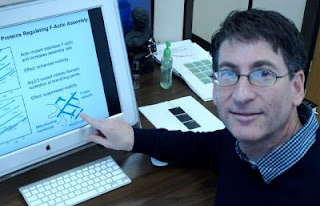University of Oregon-made technique is putting new light on machinery driving intracellular transport.
Using new technology developed in his University of Oregon lab, chemist Andrew H. Marcus and his doctoral student Eric N. Senning have captured what they describe as well-orchestrated, actin-driven, mitochondrial movement within a single cell.
That movement -- documented in a paper appearing online the week of Dec. 14-18 ahead of regular publication in the Proceedings of the National Academy of Sciences -- appears to be coordinated by mitochondria's recruitment of actin-related proteins that rapidly assemble into extended fractal-like structures in a molecular chemical reaction known as polymerization.
In their project published by PNAS -- funded by the NIH -- Senning and Marcus looked at actin's behavior using inhibitory agents to monitor mitochondrial activity in Saccharomyces cerevisiae, a species of budding yeast often used in research. They also introduced two defective forms of the protein. Their technique included the use of hormones to trick a yeast cell into thinking it was about to mate, so that it stops dividing and sits and fluctuates -- much like a car in idle. From this state, the images are drawn.
The picture that emerged, Marcus said, was that actin is drawn to the surfaces of mitochondria to regulate the polymerization machinery so that it operates in an efficient, organized manner. The findings, the researchers wrote, lend support to an existing model in which non-equilibrium forces are directly coupled to mitochondrial membrane surfaces. In effect, the findings support the idea that despite the cramped quarters of molecules in densely packed cells, intracellular transport is accomplished by coordinating the movements of a multi-faceted machine, rather than resulting from random (Brownian) movements of material based on what obstacles will allow.
The quest for understanding the machinery is more than just biological, where this research provides insight into how the cell moves its mitochondria into the daughter cells, Marcus said. The knowledge could become useful in the production of nanotechnology devices.
"A central question in modeling cell transport is whether the cytoplasm may be viewed as a simple extension of a complex fluid at equilibrium or if non-equilibrium effects dominate the motions of intracellular species," he said. "If somebody wants to design a micron-scale machine or make a self-replicating device, one would have to have these physical principles in place. One would need to have a motor in place and know how much force the motor needs to apply, either cooperatively or individually with other components." ###
Marcus is a member of the UO's Oregon Center for Optics, and an associate member of the Institute of Molecular Biology and the Materials Science Institute.
About the University of Oregon
The University of Oregon is a world-class teaching and research institution and Oregon's flagship public university. The UO is a member of the Association of American Universities (AAU), an organization made up of the 62 leading public and private research institutions in the United States and Canada. The UO is one of only two AAU members in the Pacific Northwest.
Source: Andrew H. Marcus, associate professor of chemistry, 541-346-4809, ahmarcus@uoregon.edu
Links:
- Marcus research: molbio.uoregon.edu/facres/marcus
- Institute of Molecular Biology: molbio.uoregon.edu/
- Material Sciences Institute: materialscience.uoregon.edu/
- Oregon Center for Optics: oco.uoregon.edu/
- Chemistry department: www.uoregon.edu/~chem/
jebarlow@uoregon.edu
541-346-3481 University of Oregon















No comments:
Post a Comment